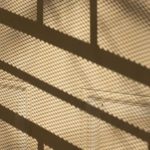
The Tennant T7AMR parts manual is a comprehensive guide essential for maintenance and repair. It includes exploded diagrams, part numbers, and troubleshooting tips, supporting both new and experienced users effectively.
1;1 Overview of the Tennant T7AMR
The Tennant T7AMR is an autonomous, battery-powered, ride-on floor scrubber designed for efficient cleaning in complex environments. Built with a compact design, it excels in tight spaces and diverse surfaces, including concrete, tile, and stone. Equipped with intuitive manual and mapping controls, it simplifies operation for all users. The T7AMR leverages advanced BrainOS technology for autonomous functionality, enabling it to navigate and clean independently. Its robust construction and versatile features make it ideal for industrial and commercial settings, ensuring consistent and high-quality cleaning results. The machine’s compact size and autonomous capabilities allow it to adapt to dynamic environments, freeing staff to focus on high-value tasks. With its user-friendly interface and advanced navigation system, the T7AMR is a reliable solution for maintaining clean and safe spaces efficiently.
1.2 Importance of the Parts Manual
The Tennant T7AMR parts manual is an indispensable resource for maintaining and repairing the machine. It provides detailed information on components, including part numbers, exploded diagrams, and troubleshooting tips, ensuring quick identification and resolution of issues. This manual is crucial for preventing downtime and extending the lifespan of the T7AMR. By referencing the guide, users can accurately order genuine or equivalent parts, ensuring compatibility and performance. The manual also serves as a comprehensive tool for daily, weekly, and monthly maintenance routines, helping users keep the machine in optimal condition. Its clear instructions and diagrams enable both novice and experienced technicians to perform repairs efficiently. Ultimately, the parts manual is essential for maximizing the T7AMR’s reliability, productivity, and safety, making it a vital companion for anyone responsible for its upkeep and operation.
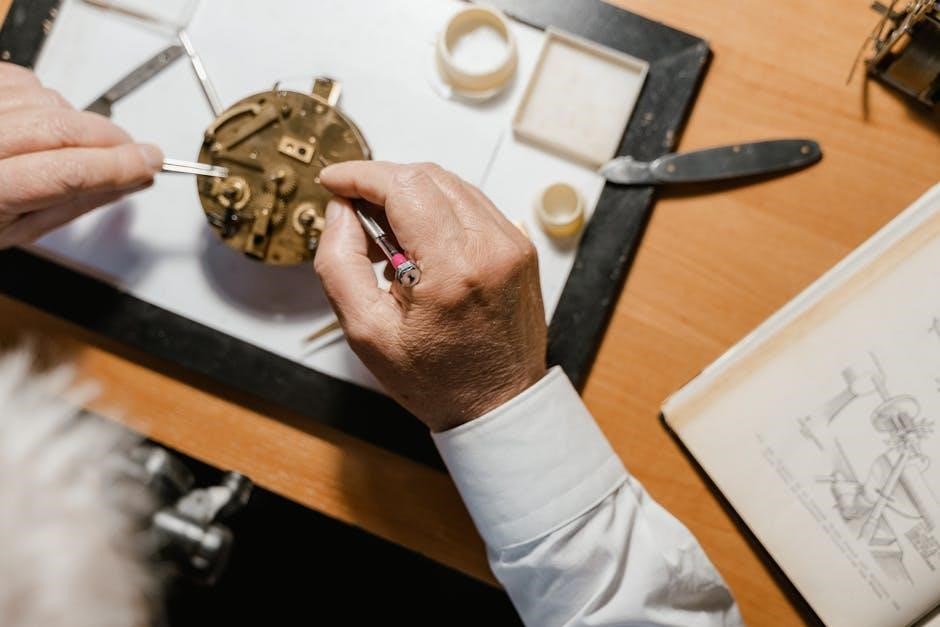
Key Components of the Tennant T7AMR
The Tennant T7AMR features brushes, squeegees, motors, drive systems, batteries, electrical components, control panels, and user interfaces, all essential for its autonomous operation and cleaning efficiency.
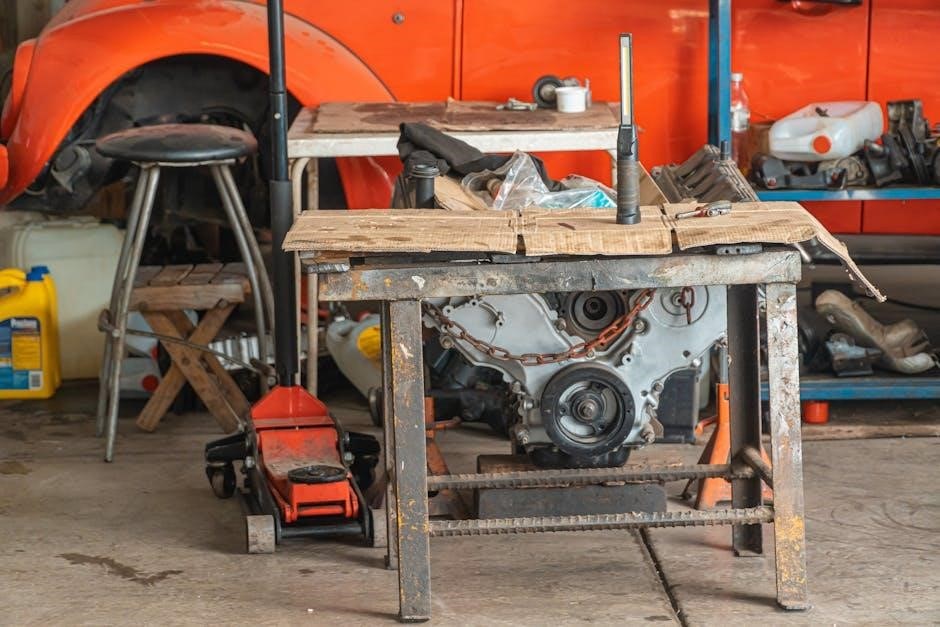
2.1 Brushes and Squeegees
The Tennant T7AMR utilizes high-quality brushes and squeegees designed for optimal cleaning performance. Brushes are available in various types, including nylon, polypropylene, and combination, to suit different floor surfaces. Regular maintenance, such as cleaning and inspecting for wear, ensures prolonged lifespan. Squeegees are crafted from durable rubber or polyurethane, ensuring effective water pickup and minimizing streaks. Proper alignment and tension of squeegees are critical for consistent results. Both components are easily replaceable, with the parts manual providing clear diagrams and part numbers. Operators are advised to refer to the manual for guidance on selecting the right brushes and squeegees for specific tasks. Routine inspections and timely replacements help maintain the machine’s efficiency and prevent damage to floors. The Tennant T7AMR parts manual also outlines compatible aftermarket options, ensuring accessibility for users worldwide.
2.2 Motors and Drive Systems
The Tennant T7AMR is powered by robust motors and drive systems designed for reliable performance. These components are engineered to handle the machine’s autonomous operations, ensuring smooth navigation and efficient cleaning. The drive system includes high-torque motors that provide consistent power, enabling the machine to traverse various floor types effortlessly. Regular lubrication of gears and inspection of motor brushes are crucial for maintaining optimal function. The parts manual provides detailed diagrams and part numbers for motor components, making identification and replacement straightforward. Operators can source genuine Tennant parts or equivalent aftermarket options from trusted suppliers. Proper maintenance of the drive system is vital to prevent operational disruptions and extend the machine’s lifespan; By adhering to the manual’s guidelines, users can ensure their T7AMR continues to perform at peak efficiency, minimizing downtime and maximizing productivity.
2.3 Batteries and Electrical Components
The Tennant T7AMR relies on advanced batteries and electrical components to power its autonomous operations. These systems are critical for ensuring consistent performance and longevity. Regular inspection of battery terminals and connections is essential to prevent power loss. The parts manual provides detailed guidance on battery maintenance, including charging procedures and troubleshooting common electrical issues. Operators are advised to use only genuine Tennant parts or approved equivalents to maintain system integrity. Proper handling of electrical components is emphasized to avoid damage or safety hazards. The manual also includes diagrams to help identify and replace components like voltage regulators or motor controllers. By following the recommended maintenance routines, users can optimize battery life and ensure reliable operation of the T7AMR. This section is vital for anyone involved in servicing or maintaining the machine’s electrical and battery systems.
2.4 Control Panels and User Interfaces
The Tennant T7AMR features advanced control panels and user interfaces designed for intuitive operation. These components are central to navigating the machine’s autonomous and manual modes. The control panel includes buttons, screens, and sensors that enable operators to program cleaning routes, monitor progress, and adjust settings. Regular cleaning of the interface and checking for software updates are recommended to ensure optimal functionality. The parts manual provides detailed diagrams and part numbers for components like touchscreens, joysticks, and sensors, making it easier to identify and replace worn or damaged elements. Proper calibration and maintenance of these systems are crucial for accurate navigation and efficient cleaning. Operators can refer to the manual for troubleshooting guides to resolve common issues quickly. This section ensures users can keep the control systems in prime condition, supporting seamless operation of the T7AMR.

Maintenance and Repair Routines
Regular maintenance and repair routines are essential for optimizing the Tennant T7AMR’s performance. The parts manual outlines daily, weekly, and monthly checks to prevent downtime and ensure efficient operation.
3.1 Daily Maintenance Checks
Daily maintenance checks are crucial for ensuring the Tennant T7AMR operates efficiently and safely. Begin by inspecting the battery level and charging status, as proper power is essential for autonomous functionality. Check the condition of brushes and squeegees, ensuring they are clean and free from debris. Verify that all fluid levels, such as cleaning solution and water, are adequate. Inspect electrical connections and wiring for any signs of wear or damage. Refer to the exploded diagrams in the parts manual for quick identification of components. Ensure the control panel and user interface are functioning correctly, with no error codes displayed. Clean or replace filters as needed to maintain optimal performance. Finally, document any issues or wear and tear in a maintenance log for future reference. Addressing these checks daily helps prevent unexpected downtime and extends the lifespan of the machine.
3.2 Weekly Maintenance Procedures
Weekly maintenance for the Tennant T7AMR ensures prolonged performance and reliability. Begin by thoroughly cleaning the brushes and squeegees, removing any accumulated debris. Inspect and lubricate moving parts, such as caster wheels and brush bearings, to maintain smooth operation. Check the battery terminals for corrosion and ensure they are securely connected. Perform a detailed inspection of the electrical components, including the control panel and wiring, for any signs of wear or damage. Review the error log on the user interface and address any recurring issues. Additionally, sanitize the recovery tank and solution tank to prevent mold and bacterial growth. Refer to the parts manual for guidance on lubrication points and cleaning procedures. Regularly updating the machine’s software, if applicable, ensures optimal functionality. By following these weekly routines, you can prevent potential issues and maintain the machine’s efficiency and longevity. Always use genuine or equivalent parts for replacements to guarantee compatibility and performance.
3.3 Monthly Maintenance Requirements
Monthly maintenance is crucial for the Tennant T7AMR to ensure optimal performance and longevity. Start by performing a deep clean of the entire machine, paying special attention to hard-to-reach areas like the brush compartments and recovery tank. Inspect and replace the pre-filter and main filter in the solution system to maintain water quality and flow. Check the condition of the brushes and squeegees; replace them if worn or damaged. Lubricate the caster wheels and brush motors according to the manufacturer’s recommendations. Inspect the electrical connections and wiring for any signs of wear or corrosion. Test the battery health and ensure the water levels are appropriate if applicable. Finally, run a diagnostic test through the control panel to identify any hidden issues. Refer to the parts manual for specific instructions and part numbers. Regular monthly maintenance helps prevent unexpected downtime and ensures the machine operates at peak efficiency. Always use genuine or equivalent parts for replacements.
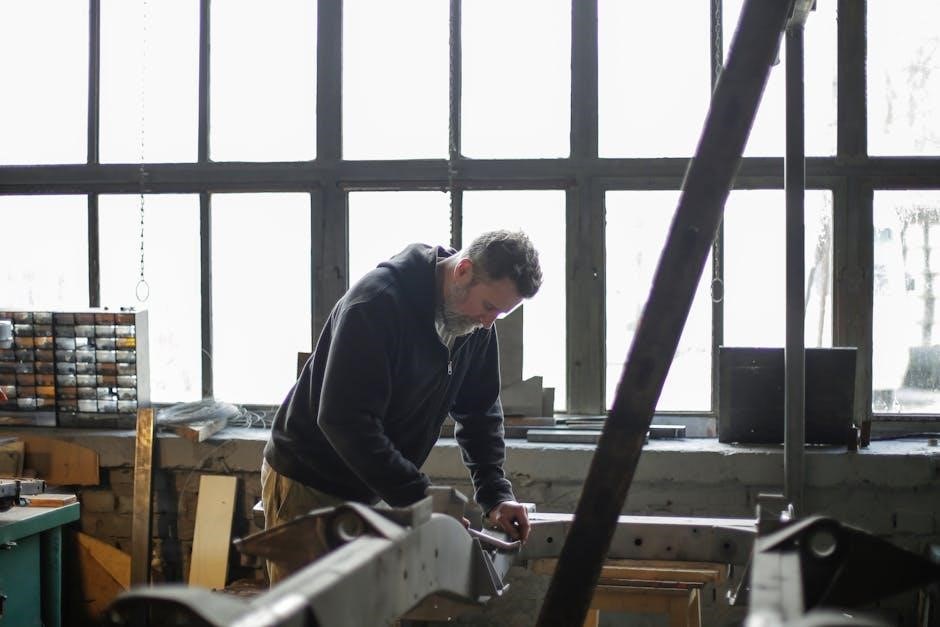
Troubleshooting Common Issues
Troubleshooting the Tennant T7AMR involves identifying common operational problems, reviewing error codes, and conducting diagnostic checks. Refer to the parts manual for solutions and part numbers to resolve issues efficiently.
4.1 Common Operational Problems
Identifying common operational issues with the Tennant T7AMR is crucial for maintaining its functionality. Issues such as reduced cleaning efficiency, battery performance problems, and navigation errors are frequently reported. The parts manual provides detailed solutions, including part replacements and diagnostic steps, to address these challenges effectively. Operators often encounter problems like malfunctioning brushes or squeegees, which can be resolved by referencing the manual for correct part numbers and installation procedures. Additionally, error codes displayed on the control panel are explained, allowing users to pinpoint specific issues and take corrective action. By understanding these common problems and their solutions, users can ensure optimal performance and extend the lifespan of their Tennant T7AMR. Regular maintenance, as outlined in the manual, plays a key role in preventing these issues from arising. Always refer to the parts manual for accurate troubleshooting and repair guidance.
4.2 Error Codes and Solutions
The Tennant T7AMR parts manual provides a detailed list of error codes and their corresponding solutions. These codes help users quickly identify issues such as battery malfunctions, motor failures, or navigation system errors. For example, error codes related to battery performance can indicate charging issues or faulty cells, while motor-related codes may signal worn brushes or electrical problems. The manual offers step-by-step solutions, including part replacements or software updates, to resolve these issues efficiently. Additionally, it guides users on how to reset error codes after troubleshooting. By referencing the manual, operators can diagnose and fix problems without specialized expertise, ensuring minimal downtime. The error code section is complemented by exploded diagrams, making it easier to locate and replace faulty components. This resource is essential for maintaining the T7AMR’s optimal performance and extending its operational lifespan.
4.3 Diagnostic Processes
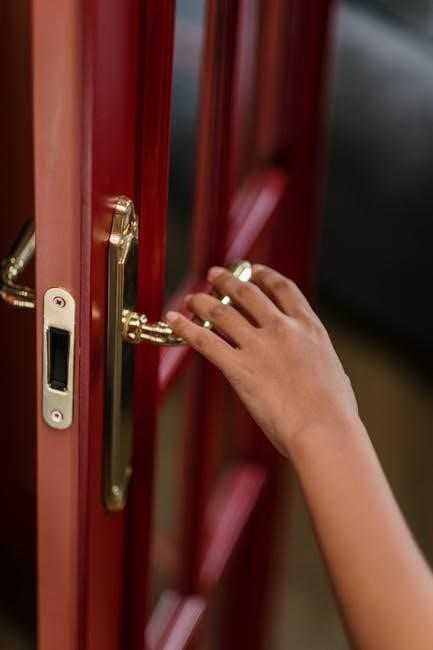
The Tennant T7AMR parts manual outlines a systematic approach to diagnosing issues, ensuring efficient troubleshooting. The manual begins with visual inspections of components like brushes, squeegees, and batteries to identify wear or damage. Users are guided to check error codes displayed on the control panel, which provide specific insights into system malfunctions. The manual also recommends testing electrical connections and verifying software updates to resolve operational glitches. Detailed flowcharts and exploded diagrams assist in pinpointing faulty parts, while step-by-step instructions walk users through advanced diagnostics. For complex issues, the manual advises consulting technical support or using specialized tools. By following these diagnostic processes, operators can quickly identify and address problems, minimizing downtime and ensuring the machine operates at peak performance. Regular diagnostic checks are encouraged to prevent unexpected failures and maintain the T7AMR’s reliability over time.
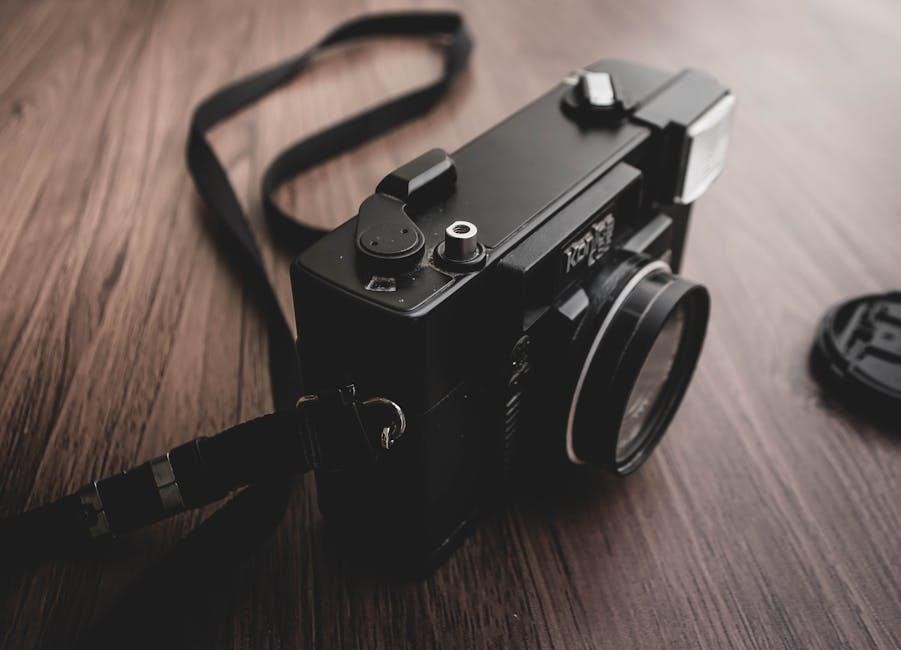
Ordering Replacement Parts
Parts can be ordered online, by phone, fax, or mail. Use the Tennant T7AMR parts manual to identify correct part numbers and ensure compatibility. Always opt for genuine or equivalent parts to maintain performance and warranty validity.
5.1 Identifying Part Numbers
Identifying the correct part numbers for the Tennant T7AMR is crucial for ensuring accurate and timely orders. The parts manual provides detailed lists and exploded diagrams to help locate and verify each component. Users can find part numbers by referencing the machine’s model and serial number, located on the data label. Cross-referencing these numbers with the manual’s parts list ensures the correct items are selected. Additionally, the manual includes visual aids like diagrams to help users identify parts visually. For complex or unclear cases, contacting Tennant support or authorized dealers can provide clarification. Always use the official Tennant T7AMR parts manual to avoid mismatches, as incorrect parts may void warranties or affect performance. Accurate identification ensures compatibility and extends the machine’s lifespan, making it essential for efficient maintenance and repair processes.
5.2 Sources for Genuine and Aftermarket Parts
Obtaining genuine and aftermarket parts for the Tennant T7AMR can be done through various trusted sources. Tennant Company directly supplies OEM parts, ensuring quality and compatibility. Authorized dealers and distributors, such as SweepScrub, also offer a wide range of components, including brushes, squeegees, and motors. For convenience, parts can be ordered online through Tennant’s official website or via phone, fax, or mail. Aftermarket parts are available from reputable third-party suppliers, often at competitive prices, but users should verify their compatibility and quality. Always ensure that aftermarket parts meet Tennant’s specifications to maintain machine performance and warranty validity. Consulting the parts manual or contacting Tennant support can help identify trusted suppliers. Prioritizing genuine or equivalent parts ensures reliability and extends the lifespan of the T7AMR, making it essential for effective maintenance and operation.
5.3 Placing Orders Online or via Phone
Ordering parts for the Tennant T7AMR is a straightforward process, with multiple convenient options available. Parts can be purchased directly from Tennant’s official website, which offers a user-friendly interface for identifying and selecting components. Additionally, orders can be placed over the phone by contacting Tennant’s customer service or authorized distributors. When placing an order, it is essential to have the machine’s model number and serial number readily available, as these details ensure accurate part identification. Many suppliers, like SweepScrub, also provide online catalogs with exploded diagrams to simplify the ordering process. Orders can be tracked for delivery status, and most suppliers offer fast shipping options to minimize downtime. For assistance, customers can contact Tennant’s support team or consult the parts manual for guidance on placing orders efficiently and effectively.
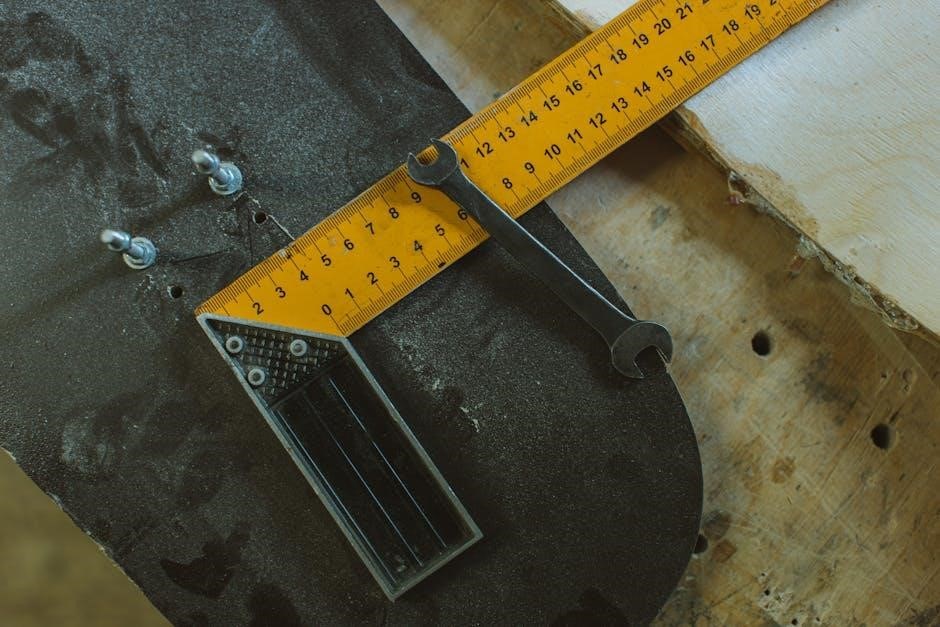
Safety Precautions and Guidelines
The Tennant T7AMR parts manual emphasizes general safety tips, proper handling of hazardous materials, and the use of safety equipment. Always use Tennant-approved parts and follow guidelines to ensure safe maintenance and operation. Wear protective gear and adhere to all safety protocols.
6.1 General Safety Tips
When working with the Tennant T7AMR, prioritize safety to avoid injuries and equipment damage. Always disconnect the battery before performing maintenance or repairs. Wear protective gear, including gloves and safety glasses, to prevent accidents. Ensure proper ventilation when handling batteries or chemicals. Avoid wearing loose clothing that could get caught in moving parts. Keep the work area clean and well-lit to minimize hazards. Follow the manufacturer’s guidelines for handling hazardous materials. Use only Tennant-approved or equivalent parts to maintain safety standards. Never bypass safety features or override system warnings. Refer to the parts manual for specific precautions related to electrical components, batteries, and mechanical systems. Adhere to all safety protocols to ensure safe operation and maintenance of the T7AMR. Regularly review safety guidelines to stay informed and maintain a safe working environment.
6.2 Handling Hazardous Materials
Handling hazardous materials when working with the Tennant T7AMR requires careful attention to safety protocols. Always identify and label hazardous substances, such as batteries, cleaning agents, or chemical solutions, as outlined in the parts manual. Wear appropriate personal protective equipment (PPE), including gloves, goggles, and a face mask, when handling these materials. Ensure proper ventilation in the workspace to prevent inhalation of fumes. Store hazardous materials in approved containers and keep them away from heat sources or flammable substances. Dispose of hazardous waste according to local regulations and manufacturer guidelines. Never mix chemicals unless explicitly instructed by the manual. Use spill kits to contain and clean up accidental spills immediately. Refer to the Tennant T7AMR parts manual for specific handling instructions and safety data sheets (SDS) for chemical products. Follow these precautions to minimize risks and ensure a safe working environment.
6;3 Proper Use of Safety Equipment
The proper use of safety equipment is critical when maintaining or repairing the Tennant T7AMR. Always wear personal protective equipment (PPE) such as gloves, safety goggles, and a face mask when handling hazardous materials or performing repairs. Ensure all safety gear meets industry standards and is in good condition. Before starting any task, inspect the equipment for damage or wear and tear. Store safety equipment in a clean, dry place to maintain its effectiveness. Familiarize yourself with the location and operation of emergency shutdown buttons and fire extinguishers. Use proper lifting techniques to avoid injury when handling heavy parts or components. Refer to the Tennant T7AMR parts manual for specific safety guidelines and equipment recommendations. By adhering to these practices, you can minimize risks and ensure a safe working environment while servicing the machine.
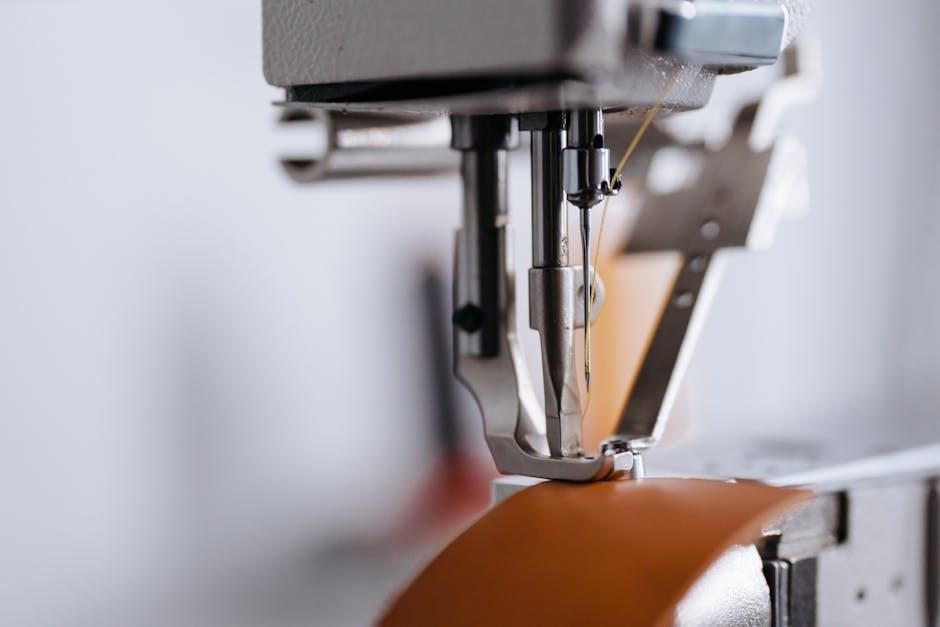
Additional Resources
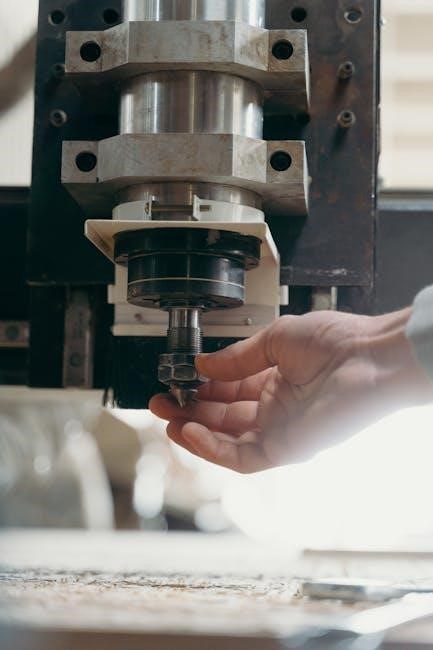
The Tennant T7AMR parts manual offers additional resources, including exploded diagrams, online support, and technical assistance. These tools provide detailed guidance for repairs, troubleshooting, and maintenance, ensuring efficient and accurate servicing of the machine.
7.1 Exploded Diagrams and Illustrations
Exploded diagrams and illustrations in the Tennant T7AMR parts manual provide a detailed visual breakdown of the machine’s components. These diagrams are essential for identifying parts, understanding their assembly, and guiding repairs. By visually representing how components fit together, users can easily locate and order the correct replacement parts. The diagrams cover key systems, such as brushes, squeegees, motors, and electrical components, ensuring clarity and precision. They are particularly useful for technicians and operators who may need to dismantle or reassemble parts during maintenance or troubleshooting. The visual representations also help users verify the compatibility of parts before ordering, reducing errors and downtime. Whether for routine maintenance or complex repairs, the exploded diagrams are an invaluable resource for anyone working with the Tennant T7AMR, making the manual a comprehensive tool for efficient servicing.
7.2 Online Support and Technical Assistance
Online support and technical assistance for the Tennant T7AMR are readily available, ensuring users have access to resources whenever they need them. Tennant’s official website provides downloadable manuals, troubleshooting guides, and repair instructions. Additionally, online forums and technical support platforms offer solutions to common issues, helping users resolve problems quickly. For more complex challenges, direct access to Tennant’s customer service team is available via phone, email, or live chat. Authorized dealers and OEM suppliers, such as SweepScrub, also provide online support, offering detailed part catalogs and repair guides. These resources are designed to minimize downtime and ensure the T7AMR operates at peak performance. By leveraging these online tools, users can troubleshoot, order parts, and maintain their machine efficiently, making the Tennant T7AMR a reliable choice for industrial and commercial cleaning needs.
7.3 Glossary of Technical Terms
The glossary of technical terms in the Tennant T7AMR parts manual serves as a quick reference guide for users to understand key terminology related to the machine. Terms such as Brush Motor, Squeegee Assembly, and AMR (Autonomous Mobile Robot) are defined to ensure clarity during maintenance and repairs. This section helps users interpret technical language used in the manual, making it easier to identify parts and troubleshoot issues. The glossary also covers components like BrainOS, the operating system powering the T7AMR, and Micro-Rider, referring to the machine’s compact design. By familiarizing themselves with these terms, users can better navigate the manual and perform tasks efficiently. The glossary is particularly useful for new operators or those less familiar with robotic cleaning technology, ensuring everyone can maintain and repair the T7AMR effectively.


